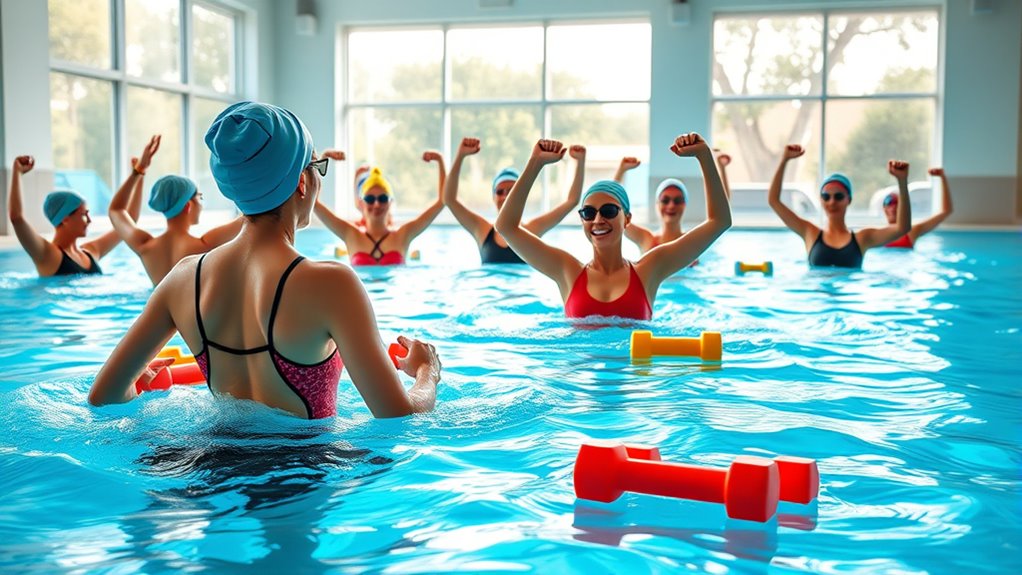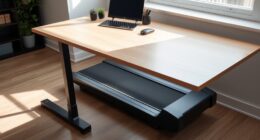If you’re new to aqua aerobics, start with simple routines focused on slow, controlled movements like water jogging, arm raises, and leg lifts, all while maintaining steady, deep breathing. Use the water’s resistance to challenge your muscles gradually and enjoy the support it provides. Keep your pace gentle at first, and focus on form and breathing for safe, effective workouts. Continue exploring, and you’ll discover how easy it is to build confidence and improve your fitness in water.
Key Takeaways
- Start with slow, controlled movements like water jogging and arm raises to build confidence and proper form.
- Incorporate rhythmic breathing techniques to enhance endurance and relaxation during routines.
- Use water resistance by increasing speed gradually for effective strength training.
- Focus on low-impact exercises that support all fitness levels, emphasizing proper posture and control.
- Maintain consistency and listen to your body to safely progress from beginner to more advanced aqua workouts.

Starting aqua aerobics as a beginner can be both fun and rewarding, even if you’ve never exercised in water before. One of the key benefits of water-based workouts is water resistance, which provides natural support and gentle resistance to your movements. As you start, you’ll quickly notice how water resistance challenges your muscles without the need for heavy weights or equipment. This resistance helps build strength and endurance safely, making your workouts effective yet low-impact. To maximize the benefits, focus on controlling your movements and maintaining proper breathing techniques. Breathing steadily and deeply ensures your oxygen intake keeps up, preventing fatigue and helping you stay relaxed in the water. Practicing controlled breathing also helps you stay calm and focused, which is especially important when learning new routines.
When beginning aqua aerobics, it’s essential to familiarize yourself with basic water resistance principles. As you move through water, resistance naturally increases with your speed and effort. For example, when doing arm circles or leg lifts, moving more slowly allows you to feel the resistance more clearly, helping you develop better control. As you become more comfortable, gradually increase your pace to challenge your muscles further. Keep in mind that water resistance is gentle but persistent, so you’ll notice improvements in strength and stamina over time. Incorporating proper breathing techniques during your routines is equally important. Inhale deeply through your nose as you prepare for a movement, then exhale fully through your mouth or nose as you execute it. This rhythmic breathing helps you maintain a steady flow of oxygen, reduces the risk of cramping, and keeps you relaxed despite the effort. Additionally, understanding water resistance principles can help you tailor your routines for maximum effectiveness.
As a beginner, start with simple routines that focus on slow, controlled movements. Practice breathing techniques consistently to develop a rhythm that feels natural. For example, during water jogging or arm raises, synchronize your breaths with your motions—inhale during the upward or recovery phase, and exhale during exertion. This habit not only improves your oxygen intake but also enhances your overall coordination. It’s normal to feel a bit challenged at first, but stay patient and listen to your body. Enjoy the buoyancy and support water offers, which makes it easier to perform movements with proper form. Over time, these foundational skills will translate into more advanced routines, boosting your confidence and fitness levels in the water. Remember, consistency is key—regular practice will help you harness the full benefits of water resistance and breathing techniques, making your aqua aerobics journey both enjoyable and effective.
Frequently Asked Questions
Can Aqua Aerobics Help With Weight Loss Effectively?
Yes, aqua aerobics can help you lose weight effectively. The hydrotherapy benefits, like low-impact exercise, reduce joint strain while still burning calories. The aquatic resistance makes movements more challenging, boosting your calorie burn and muscle toning. Consistent participation in aqua aerobics improves cardiovascular health and promotes weight loss, especially for those with joint issues or injury recovery. It’s an enjoyable way to stay active and shed pounds gradually.
Are There Any Special Precautions for Seniors?
Wondering if seniors should take extra precautions? Absolutely. You should confirm the water temperature is warm enough—around 83-88°F—to prevent muscle strains and keep comfortable. Consider your mobility; choose routines that match your ability level to avoid falls or injuries. Always consult your doctor before starting new exercises, and listen to your body. Proper supervision and gradual progression help you enjoy the benefits safely and comfortably.
How Often Should Beginners Practice Weekly?
You should practice aqua aerobics about 2 to 3 times a week, allowing your body time to recover and adapt. Focus on frequency planning to build consistency and avoid overexertion. As you become more comfortable, gradually increase your sessions to enhance skill development. Listening to your body is key; if you feel fatigued, take a rest day to prevent injury and guarantee steady progress in your fitness journey.
Do I Need Prior Swimming Experience to Start?
You don’t need swimming proficiency or water comfort to start aqua aerobics; think of it as planting a seed in a calm pond. As you gain confidence, your water comfort will grow naturally. Beginners often start with little swimming experience, just like a seed needs nurturing. The key is a willingness to learn and enjoy the water, which helps you build skills gradually and feel more at ease in the pool.
What Equipment Is Necessary for Beginner Routines?
You only need basic equipment for beginner aqua aerobics routines. Water shoes help prevent slips and protect your feet, while a waterproof stopwatch allows you to track your exercise time accurately. No fancy gear is necessary—just wear comfortable swimwear and bring your water shoes and stopwatch. These items make your workout safer and more efficient, helping you stay motivated and on schedule throughout your aqua aerobics journey.
Conclusion
As you start your aqua aerobics journey, you’ll notice how the water’s support makes every move easier, almost like the pool itself is cheering you on. Coincidentally, many beginners find that just a few sessions boost their energy and confidence faster than they expected. Keep practicing these routines, and you’ll soon realize that the water isn’t just a medium — it’s your ally in achieving fitness and fun, turning simple moves into a rewarding experience.










